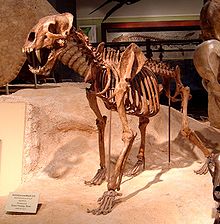| Homotherium Temporal range: Early Pliocene to Late Pleistocene,
| |
|---|---|

| |
| Skeleton of H. serum from Friesenhahn cave, Texas Science & Natural History Museum, University of Texas at Austin, Austin, Texas. | |
| Scientific classification | |
| Domain: | Eukaryota |
| Kingdom: | Animalia |
| Phylum: | Chordata |
| Class: | Mammalia |
| Order: | Carnivora |
| Suborder: | Feliformia |
| Family: | Felidae |
| Subfamily: | †Machairodontinae |
| Tribe: | †Homotherini |
| Genus: | †Homotherium Fabrini, 1890 |
| Type species | |
| Homotherium latidens Owen, 1846
| |
| Other species | |
For others, see text | |
| Synonyms | |
| |
Homotherium is an extinct genus of scimitar-toothed cat belonging to the extinct subfamily Machairodontinae that inhabited North America, Eurasia, and Africa (as well as possibly South America) during the Pliocene and Pleistocene epochs from around 4 million to 12,000 years ago.[1][2] It was one of the last surviving members of the subfamily alongside the more famous sabertooth Smilodon, to which it was not particularly closely related. It was a large cat, comparable in size to a lion, functioning as an apex predator in the ecosystems it inhabited. In comparison to Smilodon, the canines of Homotherium were shorter (though still longer than those of living cats), and it is suggested to have a had different ecology from Smilodon as a pursuit predator adapted to running down large prey in open habitats, with Homotherium also proposed to have likely engaged in cooperative hunting.
- ^ a b Antón, Mauricio (2013). Sabertooth. Life of the past. Bloomington: Indiana University Press. ISBN 978-0-253-01042-1.
- ^ Turner, A. (1997). 'The big cats and their fossil relatives. Columbia University Press. ISBN 0-231-10229-1